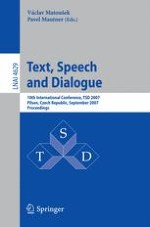2007 | Buch
Text, Speech and Dialogue
10th International Conference, TSD 2007, Pilsen, Czech Republic, September 3-7, 2007. Proceedings
herausgegeben von: Václav Matoušek, Pavel Mautner
Verlag: Springer Berlin Heidelberg
Buchreihe : Lecture Notes in Computer Science
